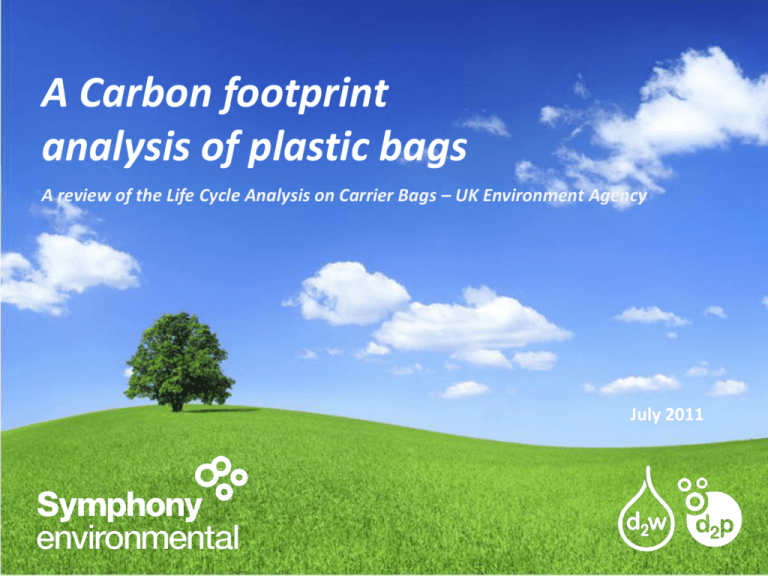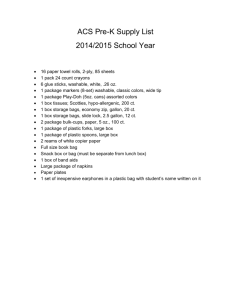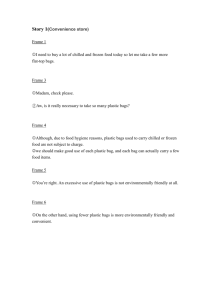Carbon Footprint Analysis of Plastic Bags: UK Study Review
advertisement

A Carbon footprint analysis of plastic bags A review of the Life Cycle Analysis on Carrier Bags – UK Environment Agency July 2011 1 Background In February 2011, The UK Environment Agency published a report, Life Cycle Analysis on Carrier Bags. -An assessment across all types of carrier bags • Conventional plastic • Hydro-biodegradable plastic • Oxo-biodegradable plastic • Cotton/Jute • Paper 2 Carbon Footprint of Plastic Bags The UK Environment Agency study shows how plastic bags* are the most environmentally friendly. If these were banned, it would actually be worse for the environment as the alternatives to plastic bags have a higher Global Warming Potential. *Conventional HDPE plastic bag Source: UK Environmental Agency CO2 impact of carrier bags Everyday actions compared to bags 1 Average daily car trip1 = 781 bags 1 Long haul flight2 = 137,000 bags 1Based 2Based on: 30 mile trip, 12,000 miles per year, 2008 Ford Focus 1.6 (10kg CO2) on: Return flight from London Heathrow to Hong Kong (1,750kg CO2) 4 Global Warming Potential The following shows the GWP of different carrier bags, made from a variety of materials Bag type Average bag weight (g) CO2 equivalent per 1 kg of bags CO2 equivalent per bag (kg) HDPE vest carrier 8.12 1.578 0.0128 Oxo-degradable vest carrier 8.27 1.750 0.0145 Starch based biodegradable vest 16.49 4.184 0.0690 Paper bag 55.2 5.525 0.305 LDPE ‘Bag for Life’ 34.94 6.924 0.242 Non woven PP bag 115.83 21.510 2.491 120 23.088 2.770 183.11 271.533 49.720 190 273.111 51.891 Woven PP Bag Cotton bag Jute bag 5 Global Warming Potential What is it? Global Warming Potential (GWP) gives an indication of gas release which contributes to global warming Examples of Global Warming Gas: • Water vapour • Carbon dioxide • Methane • Nitrous oxide • Others Global Warming Potential Comparison: plastic bags and other bags How many times do you need to re-use one of these bags to have the same GWP? HDPE plastic bag LDPE “Bag for Life” Paper bag Non woven PP Bag Cotton/jute bag 1 4 5 14 173 Source: UK Environmental Agency 2011 Global Warming Potential Comparison: plastic bags and other bags If carrier bags are re-used (as most of them are), the impact on the environment is greatly reduced. Bag type First use 40.28% Second use (UK average) 100% Second use (ideal) HDPE bag 2.082 1.578 0.830 Oxo-biodegradable bag 2.254 1.750 1.003 Starch based biodegradable bag 4.691 4.184 n/a* *Unlikely to be achievable due to the type of material used. Kg/CO2 equivalency Global Warming Potential Total CO2 impact of different carrier bags HDPE plastic bag oil extraction manufacture Bag weight: 8.12g transport Waste processes 7.68 g 3.58 4g 0.89 6g 0.64 g Global Warming Potential Total CO2 impact of different carrier bags Oxo-biodegradable plastic bag Bag weight: 8.27g oil extraction manufacture transport Waste processes Carbon footprint per bag 8.7g 4.032g 1.015g 0.725g 14.5g Global Warming Potential Total CO2 impact of different carrier bags Starch based bag Bag weight: 16.49g Grown crops Extraction/production of raw materials transport Waste processes Carbon footprint per bag 0g* 34.5g 13.8g 20.7g 69g *The CO2 released from bio-degradation is the same as that absorbed by the crop during its growing cycle. Global Warming Potential Total CO2 impact of different carrier bags Paper bag Bag weight: 55.2g Grown crops Material production/manufacture transport Waste processes Carbon footprint per bag 0g* 228.7 5g 39.65g 36.6g 305g *The CO2 released from bio-degradation is the same as that absorbed by the crop during its growing cycle. Global Warming Potential Total CO2 impact of different carrier bags LDPE Flexi-loop bag Bag weight: 34.94g Grown crops Material production/manufacture transport Waste processes Carbon footprint per bag 157.3g 48.4g 16.94g 19.36g 242g Global Warming Potential Total CO2 impact of different carrier bags Non woven PP bag Bag weight: 115.83g Oil extraction Manufacture transport Waste processes Carbon footprint per bag 1.868g 249.1g 249.1g 124.55 g 2491g Global Warming Potential Total CO2 impact of different carrier bags Woven PP bag Bag weight: 120g Oil extraction Manufacture transport Waste processes Carbon footprint per bag 2.077g 277g 277g 138.5g 2770g Global Warming Potential Total CO2 impact of different carrier bags Cotton bag Grown crops Manufacture Bag weight: 183.11g 0g* 42.26 2g transport 4.972g Waste processes 2.486g Carbon footprint per bag 49.72 *The CO released from bio-degradation is the same as that absorbed by the crop during its growing cycle. 0g 2 Global Warming Potential Total CO2 impact of different carrier bags Jute bag Bag weight: 183.11g Grown crops Manufacture transport Waste processes Carbon footprint per bag 0g* 44.11g 5.189g 2.595g 51.89 1g *The CO2 released from bio-degradation is the same as that absorbed by the crop during its growing cycle. Global Warming Potential Total CO2 impact of different carrier bags Cotton bag Grown crops Manufacture Bag weight: 183.11g 0g* 42.26 2g transport 4.972 g Waste processes 2.486 *The CO released from bio-degradation is the same as that absorbed by the crop during its g growing cycle. Carbon footprint per bag 49.72 2 Other comparisons Other ways to consider the impact Paper vs Plastic Paper bags have a much higher level of impact on the environment compared to plastic bags. Height of 1000 bags 117 cm 10.16 cm Weight of 1000 bags 63.50 kg 7.26 kg Shipping/Energy 100% 18% Fresh water usage 100% 3% Waste generation 100% 20% Recyclability 100% 9% Source: Peer Reviewed Published data: Franklin Associates, David Cornell, et al. US Environmental Protection Agency. Questions about your Community Shopping Bags: Paper or Plastic DOE Energy Information Administration True or False about bags Myths and facts on plastic carrier bags Plastic bags are a problem to the environment-both land and sea-if not recycled or disposed of correctly TRUE Conventional plastic shopping bags have the greatest environmental impact FALSE Conventional plastic shopping bags have the lowest Global Warming Potential (GWP) TRUE Plastic used in carrier bag production requires a large amount of the world’s oil reserves FALSE Plastic used in carrier bag production is generated from a by-product of oil which used to be wasted TRUE True or False about bags Heavy duty, hand finished shopping bags are better for the environment FALSE Heavy duty, hand finished shopping bags require more resources to be produced TRUE Bags made from “sustainable” material are better for the environment FALSE Bags made from “sustainable” materials have to be reused an unrealistic number of times to achieve the equivalent GWP levels of conventional plastic shopping bags TRUE The way forward Plastic is • useful, light, flexible and durable • relatively cheap to manufacture • a by-product of oil • oil reserves are still abundant But to limit its impact on the environment, users can: • reuse plastic objects • reduce the amount of plastic required • recycle • incinerate to recover the calorific value • use a biodegrading additive Symphony Environmental Ltd info@d2w.net www.d2w.net





